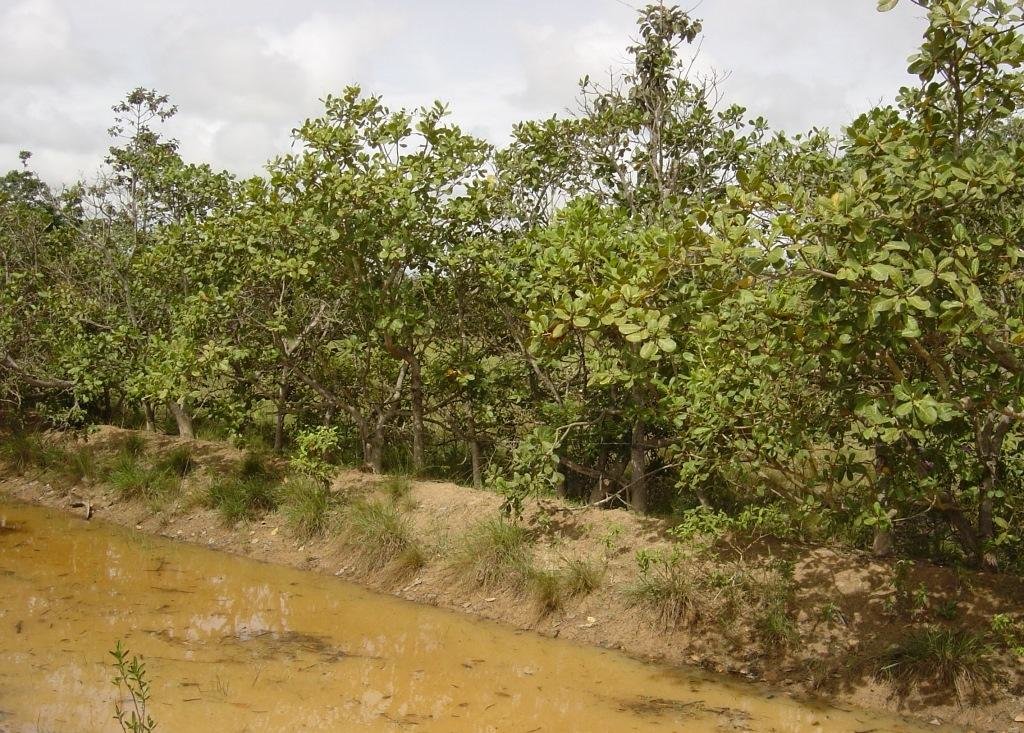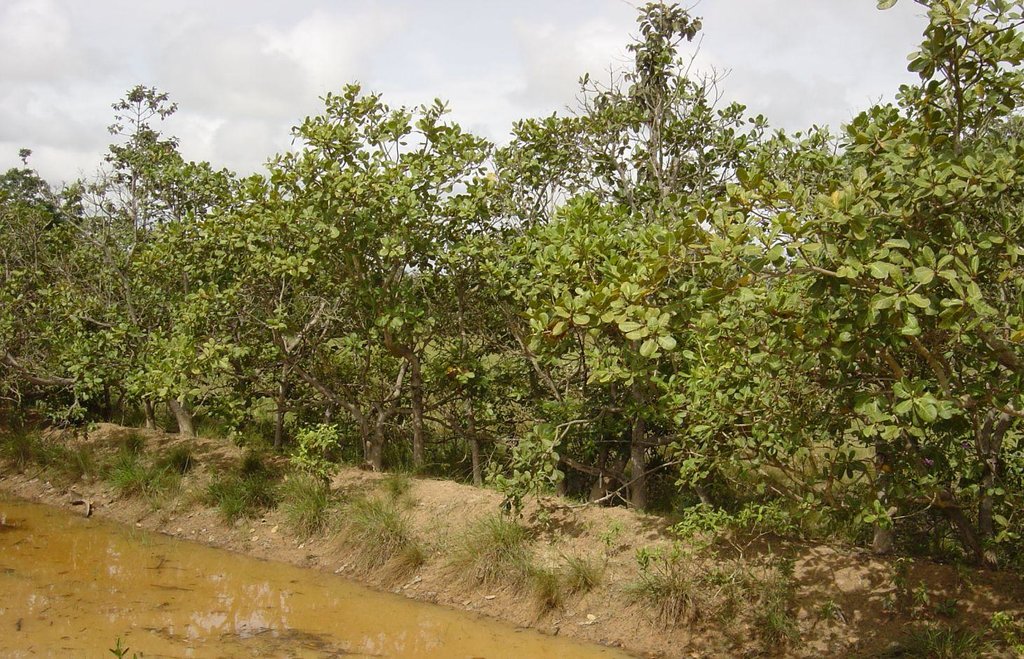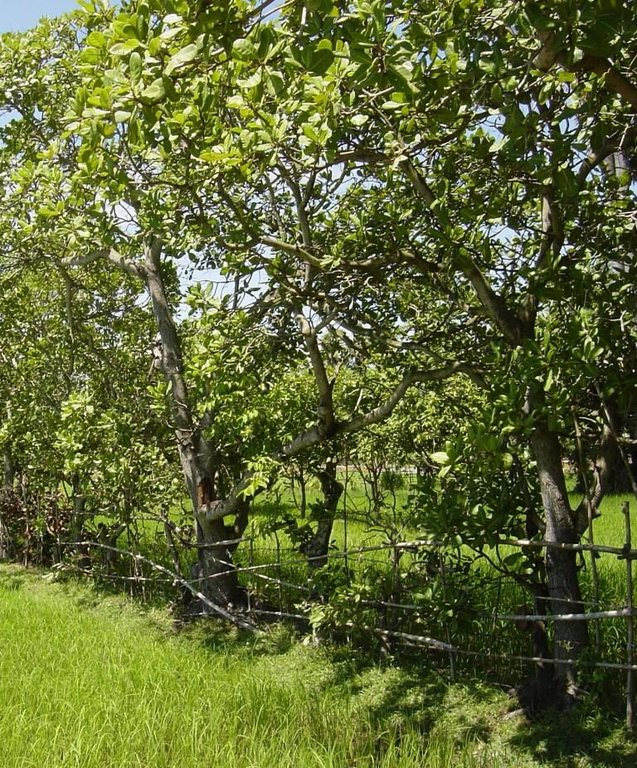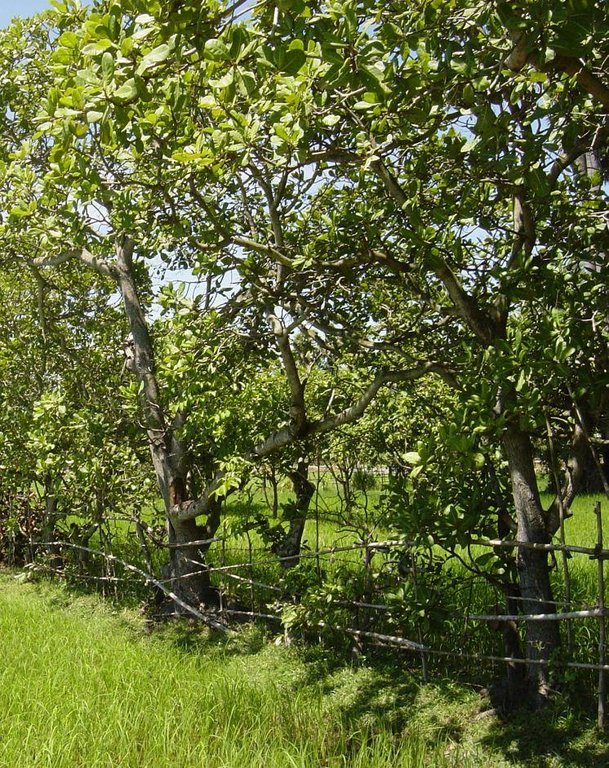Cashew living fences [柬埔寨]
- 创建:
- 更新:
- 编制者: Stefan Graf
- 编辑者: –
- 审查者: Deborah Niggli
ដំណំាចន្នីដំាជារបងរស់ (Khmer)
technologies_1643 - 柬埔寨
查看章节
全部展开 全部收起1. 一般信息
1.2 参与该技术评估和文件编制的资源人员和机构的联系方式
SLM专业人员:
Khun Lean Hak
kleanghak@yahoo.com / sofdec@camintel.com
SOFDEC/LAREC, www.sofdec.org
柬埔寨
SLM专业人员:
Sreytouch Bin
Sreytouchbin@gmail.com
SOFDEC
柬埔寨
SLM专业人员:
Pith Khonhel
khonhel@gmail.com
LAREC
柬埔寨
有助于对技术进行记录/评估的机构名称(如相关)
Society for Community Development in Cambodia (SOFDEC) - 柬埔寨有助于对技术进行记录/评估的机构名称(如相关)
Local Agricultural Research and Extension Centre (LAREC) - 柬埔寨1.3 关于使用通过WOCAT记录的数据的条件
(现场)数据是什么时候汇编的?:
06/08/2014
编制者和关键资源人员接受有关使用通过WOCAT记录数据的条件。:
是
1.4 所述技术的可持续性声明
这里所描述的技术在土地退化方面是否存在问题,导致无法被认为是一种可持续的土地管理技术?:
否
2. SLM技术的说明
2.1 技术简介
技术定义:
Living fences of cashew, reinforced with bamboo and/or barbed wire, are used to keep the cattle off the garden or the rice seedbed.
2.2 技术的详细说明
说明:
Cashews (Anacardium occidentale) are fast growing, waterlogging tolerant tropical trees that can be used as living fences. The cashews act as fence posts, and are reinforced with bamboo poles and/or barbed wire. The living fences are used to either fence cattle into fields or fence them off, usually around the house. The fenced areas can be planted during the dry season. Without fences, the cattle are free roaming and use to destroy the crops.
Besides fencing the cattle, the purposes of cashew living fences are the production of nuts and fruits, fuel, and soil enhancer. The nuts are sold, but there is no market for the fruits, thus they are fed to cattle or let to rot. The wood is used to cook or to produce charcoal; the ash is added to the compost. The leaves are gathered as well and added to the compost.
Although cashews can stand waterlogged conditions, they prefer a well-drained soil. Thus a small berm is built up on the emplacement of the fence, and sown with cashew seeds spaced from 0.5 to 3 m. Cashews grow faster when directly sown than when transplanted. The spacing varies according to the farmers’ purpose. If a higher production of nuts is intended, the spacing is wider; if the fence is more important, the plants are grown closer. Cattle do not eat the leaves and branches, thus do not need protection from grazing. One year after sowing the cashews, the trees are tall enough to act as fence posts and support bamboo pole as well as barbed wire. The bamboo is either gathered from the wild or grown in the fields and home gardens. The bamboo is fixed to the living posts with natural fibers/vines or old clothes, and has to be replaced every two to three years to withstand cattle.
The analysed area is flat (slope < 2%), with a tropical climate (dry season from November to May and wet season from June to October), and the soils are mostly sandy or loamy. The soil has a low fertility, contains little organic matter, and acidifies. The area has been deforested a long time ago, and the groundwater table is rather high (1-2 m during the dry season, on the surface during wet season).
Due to climate change, farmers notice more erratic rainfalls, temperature rises and more recurrent droughts. Rice is the predominant crop grown in the area, since it serves as staple food (mix subsistence and commercial activities). Cattle are usually grazing on the fields after the harvest, without much control. Thus the cattle grazes too often and too much on the same spot, leading to degradation.
The increasing migration rate (the young generation leaves the villages to work in the cities, garment industry or abroad) results in a decrease of available labour force in the area which has detrimental effects on the agricultural activities. Furthermore, the civil war in the 1970s (Khmer Rouge) led to the loss of agricultural knowledge. Several NGOs are trying to re-establish the knowledge.
2.3 技术照片
2.5 已应用该技术的、本评估所涵盖的国家/地区/地点
国家:
柬埔寨
区域/州/省:
Kampong Chhnang
有关地点的进一步说明:
Krang Liav, Rolea Pha-er
Map
×2.6 实施日期
如果不知道确切的年份,请说明大概的日期:
- 10-50年前
2.7 技术介绍
详细说明该技术是如何引入的:
- 通过土地使用者的创新
3. SLM技术的分类
3.1 该技术的主要目的
- 保护生态系统
3.2 应用该技术的当前土地利用类型

混合(作物/放牧/树木),包括农林
- 林牧业
注释:
Major land use problems (compiler’s opinion): Overgrazing, low soil fertility, sandy soils, monocultures, soil left bare after ploughing, wind and dust storms.
Major land use problems (land users’ perception): Low soil fertility, water scarcity, droughts.
3.3 有关土地利用的更多信息
该技术所应用土地的供水:
- 混合雨水灌溉
每年的生长季节数:
- 1
具体说明:
Longest growing period in days: 210, Longest growing period from month to month: June to December
牲畜密度(如相关):
25-50 LU /km2
3.4 该技术所属的SLM组
- 农畜综合管理
3.5 技术传播
具体说明该技术的分布:
- 均匀地分布在一个区域
如果该技术均匀地分布在一个区域上,请注明覆盖的大致区域。:
- < 0.1 平方千米(10 公顷)
注释:
Around 15 farmers in this village use cashew living fences.
3.6 包含该技术的可持续土地管理措施

植物措施
- V1:乔木和灌木覆盖层
注释:
Type of vegetative measures: aligned: -along boundary
3.7 该技术强调的主要土地退化类型

土壤风蚀
- Et:表土流失

化学性土壤退化
- Cn:肥力下降和有机质含量下降(非侵蚀所致)

生物性退化
- Bc:植被覆盖的减少
- Bl:土壤寿命损失
注释:
Main causes of degradation: soil management (Plowing of soil, then left bare), crop management (annual, perennial, tree/shrub) (Mainly annuals (rice) planted in monocultures.), overgrazing (Uncontrolled grazing.), labour availability (Little labour availability, mainly due to work in garment industry)
3.8 防止、减少或恢复土地退化
具体数量名该技术与土地退化有关的目标:
- 减少土地退化
- 修复/恢复严重退化的土地
4. 技术规范、实施活动、投入和成本
4.1 该技术的技术图纸
4.2 技术规范/技术图纸说明
On a dike cashews (Anacardium occidentale) were planted a few years back. After they grew up, the fence was done with barbed wire and bamboo poles.
Kampong Chhnang
Date: 2014
Technical knowledge required for field staff / advisors: low
Technical knowledge required for land users: low
Main technical functions: increase of biomass (quantity), spatial arrangement and diversification of land use
Secondary technical functions: increase in organic matter, increase in nutrient availability (supply, recycling,…), improvement of water quality, buffering / filtering water, reduction in wind speed
Aligned: -along boundary
Vegetative material: T : trees / shrubs, F : fruit trees / shrubs
Vertical interval within rows / strips / blocks (m): 0.5-3m
Fruit trees / shrubs species: Cashew, seeded.
4.3 有关投入和成本计算的一般信息
注明雇用劳工的每日平均工资成本:
5.00
4.4 技术建立活动
| 活动 | 措施类型 | 时间 | |
|---|---|---|---|
| 1. | Building small bound to sow the cashews. | 植物性的 | Dry season, before sowing |
| 2. | Sowing cashews on the bounds | 植物性的 | Beginning of rainy season |
| 3. | Gathering bamboo in the forest, building the fence | 植物性的 |
4.5 技术建立所需要的费用和投入
| 对投入进行具体说明 | 单位 | 数量 | 单位成本 | 每项投入的总成本 | 土地使用者承担的成本% | |
|---|---|---|---|---|---|---|
| 劳动力 | labour | 1.0 | 17.5 | 17.5 | 100.0 | |
| 设备 | tools | 1.0 | 12.0 | 12.0 | 100.0 | |
| 设备 | barbed wire | 1.0 | 21.0 | 21.0 | 100.0 | |
| 植物材料 | seeds | 1.0 | 1.0 | 1.0 | 100.0 | |
| 技术建立所需总成本 | 51.5 | |||||
注释:
Duration of establishment phase: 12 month(s)
4.6 维护/经常性活动
| 活动 | 措施类型 | 时间/频率 | |
|---|---|---|---|
| 1. | Gathering bamboo in the forest, building the fence | 植物性的 | Every 2-3 years |
4.7 维护/经常性活动所需要的费用和投入(每年)
| 对投入进行具体说明 | 单位 | 数量 | 单位成本 | 每项投入的总成本 | 土地使用者承担的成本% | |
|---|---|---|---|---|---|---|
| 劳动力 | labour | 1.0 | 3.0 | 3.0 | 100.0 | |
| 技术维护所需总成本 | 3.0 | |||||
注释:
Machinery/ tools: Hoe, hatchet.
The costs were calculated for 100 m of living fence, with 2 stripes of barbed wires. The barbed wire is not necessary if enough labour and bamboo is available but makes it easier to keep the cattle fenced and requires less maintenance than bamboo poles.
4.8 影响成本的最重要因素
描述影响成本的最决定性因素:
The costs are most determined by the availability of bamboo. If it is not grown in the garden, it has to be gathered in the forest that is related to time consuming transportation. Or barbed wire has to be purchased.
Note: The time used to gather the leaves for the compost or to cut the branches to make charcoal/ash as soil amendment was not included in the recurrent activities as these activities are neither related to the main purpose of living fences nor done by all the farmers applying this technology.
5. 自然和人文环境
5.1 气候
年降雨量
- < 250毫米
- 251-500毫米
- 501-750毫米
- 751-1,000毫米
- 1,001-1,500毫米
- 1,501-2,000毫米
- 2,001-3,000毫米
- 3,001-4,000毫米
- > 4,000毫米
有关降雨的规范/注释:
1486.45 mm 2013 in Kampong Chhnang
农业气候带
- 半湿润
Thermal climate class: tropics. 27-35°C
5.2 地形
平均坡度:
- 水平(0-2%)
- 缓降(3-5%)
- 平缓(6-10%)
- 滚坡(11-15%)
- 崎岖(16-30%)
- 陡峭(31-60%)
- 非常陡峭(>60%)
地形:
- 高原/平原
- 山脊
- 山坡
- 山地斜坡
- 麓坡
- 谷底
垂直分布带:
- 0-100 m a.s.l.
- 101-500 m a.s.l.
- 501-1,000 m a.s.l.
- 1,001-1,500 m a.s.l.
- 1,501-2,000 m a.s.l.
- 2,001-2,500 m a.s.l.
- 2,501-3,000 m a.s.l.
- 3,001-4,000 m a.s.l.
- > 4,000 m a.s.l.
5.3 土壤
平均土层深度:
- 非常浅(0-20厘米)
- 浅(21-50厘米)
- 中等深度(51-80厘米)
- 深(81-120厘米)
- 非常深(> 120厘米)
土壤质地(表土):
- 粗粒/轻(砂质)
- 中粒(壤土、粉土)
表土有机质:
- 中(1-3%)
- 低(<1%)
5.4 水资源可用性和质量
地下水位表:
表面上
地表水的可用性:
好
水质(未处理):
不良饮用水(需要处理)
关于水质和水量的注释和进一步规范:
During wet seasons
5.5 生物多样性
物种多样性:
- 中等
栖息地多样性:
- 中等
5.6 应用该技术的土地使用者的特征
生产系统的市场定位:
- 混合(生计/商业
非农收入:
- 收入的10-50%
相对财富水平:
- 平均水平
个人或集体:
- 个人/家庭
机械化水平:
- 手工作业
- 畜力牵引
性别:
- 女人
- 男人
说明土地使用者的其他有关特征:
Land users applying the Technology are mainly common / average land users
Population density: 10-50 persons/km2
Annual population growth: 0.5% - 1%
Off-farm income specification: handicraft, remittances and factory work
5.7 应用该技术的土地使用者拥有或租用的平均土地面积
- < 0.5 公顷
- 0.5-1 公顷
- 1-2 公顷
- 2-5公顷
- 5-15公顷
- 15-50公顷
- 50-100公顷
- 100-500公顷
- 500-1,000公顷
- 1,000-10,000公顷
- > 10,000公顷
这被认为是小规模、中规模还是大规模的(参照当地实际情况)?:
- 中等规模的
5.8 土地所有权、土地使用权和水使用权
土地所有权:
- 社区/村庄
- 个人,未命名
土地使用权:
- 社区(有组织)
- 个人
用水权:
- 自由进入(无组织)
注释:
Land users have a title that is not recognized by the state.
5.9 进入服务和基础设施的通道
健康:
- 贫瘠
- 适度的
- 好
教育:
- 贫瘠
- 适度的
- 好
技术援助:
- 贫瘠
- 适度的
- 好
就业(例如非农):
- 贫瘠
- 适度的
- 好
市场:
- 贫瘠
- 适度的
- 好
能源:
- 贫瘠
- 适度的
- 好
道路和交通:
- 贫瘠
- 适度的
- 好
饮用水和卫生设施:
- 贫瘠
- 适度的
- 好
金融服务:
- 贫瘠
- 适度的
- 好
6. 影响和结论性说明
6.1 该技术的现场影响
社会经济效应
生产
作物生产
注释/具体说明:
Due to shading and root competition.
木材生产
注释/具体说明:
Used as fuel and charcoal.
能源生产
注释/具体说明:
Firewood production.
水资源可用性和质量
灌溉用水需求
注释/具体说明:
Quality, trough bioremediation of groundwater. Difficult to quantify.
收入和成本
收入来源的多样性
注释/具体说明:
If spaced, production of cashew nuts and apples.
社会文化影响
食品安全/自给自足
注释/具体说明:
Improved self-sufficiency on firewood.
contribution to human well-being
注释/具体说明:
Every additional income source/diversification increases the human well-being.
生态影响
水循环/径流
蒸发
注释/具体说明:
But increased evapotranspiration.
土壤
养分循环/补给
注释/具体说明:
Nutrients are picked up from the groundwater, and put back into the cycle.
土壤有机物/地下C
注释/具体说明:
Leaves used for compost.
生物多样性:植被、动物
生物量/地上C
有益物种
注释/具体说明:
Wormcasts could be seen under the trees. Difficult to quantify.
栖息地多样性
注释/具体说明:
Tree layer.
减少气候和灾害风险
风速
6.2 该技术的场外影响已经显现
地下水/河流污染
注释/具体说明:
Bioremediation difficult to quantify.
风力搬运沉积物
注释/具体说明:
Slowing down of wind speed.
6.3 技术对渐变气候以及与气候相关的极端情况/灾害的暴露和敏感性(土地使用者认为的极端情况/灾害)
渐变气候
渐变气候
| 季节 | 气候变化/极端天气的类型 | 该技术是如何应对的? | |
|---|---|---|---|
| 年温度 | 增加 | 好 |
气候有关的极端情况(灾害)
气象灾害
| 该技术是如何应对的? | |
|---|---|
| 局地暴雨 | 好 |
| 局地风暴 | 好 |
气候灾害
| 该技术是如何应对的? | |
|---|---|
| 干旱 | 好 |
水文灾害
| 该技术是如何应对的? | |
|---|---|
| 比较和缓的(河道)洪水 | 好 |
其他气候相关的后果
其他气候相关的后果
| 该技术是如何应对的? | |
|---|---|
| 缩短生长期 | 好 |
6.4 成本效益分析
技术收益与技术建立成本相比如何(从土地使用者的角度看)?
短期回报:
中性/平衡
长期回报:
稍微积极
技术收益与技术维护成本/经常性成本相比如何(从土地使用者的角度看)?
短期回报:
稍微积极
长期回报:
稍微积极
6.5 技术采用
注释:
100% of land user families have adopted the Technology without any external material support
15 land user families have adopted the Technology without any external material support. These 15 families all live in this specific village. However, the technology is applied elsewhere as well.
A few years ago, one farmer could sell the cashew apples. Now there is an overproduction on the market.
6.7 该技术的优点/长处/机会
| 土地使用者眼中的长处/优势/机会 |
|---|
| Cattle are fenced in or off. The cattle do not enter the home gardens of the neighbours and cannot escape on the rice fields. |
| Branches can be used as firewood or to make charcoal, and the leaves can be used as compost |
| Production of fruits and nuts. |
| 编制者或其他关键资源人员认为的长处/优势/机会 |
|---|
| Reduced wind speed. |
| Bioremediation of groundwater. |
| Increased soil cover. |
6.8 技术的弱点/缺点/风险及其克服方法
| 土地使用者认为的弱点/缺点/风险 | 如何克服它们? |
|---|---|
| Shading of crops nearby. | Cut back the cashews since they are pollarding trees. However, this will drastically reduce the fruit production. |
| Root competition with other trees. | Plant next to shallow rooted crops. |
| No more market for cashew apples as there is an overproduction. | Process as wine or dry. Can also be fed to cattle. |
7. 参考和链接
7.1 信息的方法/来源
- 实地考察、实地调查
- 与土地使用者的访谈
链接和模块
全部展开 全部收起链接
无链接
模块
无模块








